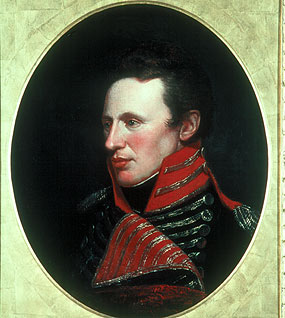
Zebulon Montgomery Pike was an American brigadier general and explorer for whom Pikes Peak in Colorado was named. As a U.S. Army officer he led two expeditions under authority of President Thomas Jefferson through the Louisiana Purchase territory, first in 1805–1806 to reconnoiter the upper northern reaches of the Mississippi River, and then in 1806–1807 to explore the southwest to the fringes of the northern Spanish-colonial settlements of New Mexico and Texas. Pike's expeditions coincided with other Jeffersonian expeditions, including the Lewis and Clark Expedition and the Red River Expedition in 1806.

Spanish Texas was one of the interior provinces of the colonial Viceroyalty of New Spain from 1690 until 1821. The term "interior provinces" first appeared in 1712, as an expression meaning "far away" provinces. It is only in 1776 that a legal jurisdiction called "Interior Provinces" is created.
José Joaquín de Arredondo y Mioño (1776–1837) was a 19th-century Spanish and Mexican soldier who served during the last two decades of Spanish rule in New Spain. He was military commandant of the Texas province during the first Texas revolutions against Spanish rule.

The Gutiérrez–Magee Expedition was an 1812–1813 joint filibustering expedition by Mexico and the United States against Spanish Texas during the early years of the Mexican War of Independence.

Teodoro de Croix was a Spanish soldier and colonial official in New Spain and Peru. From April 6, 1784 to March 25, 1790 he was viceroy of Peru.
Manuel María de Salcedo y Quiroga,, was a governor of Spanish Texas from 1808 until his execution in 1813. Salcedo gained leadership experience helping his father Juan Manuel de Salcedo, the 11th and last Spanish governor of Louisiana,. In 1807, the younger Salcedo was appointed governor of Texas, and he officially assumed that role on November 7, 1808. As governor, he and his uncle Nemesio Salcedo, the Commandant General of the Interior Provinces, often disagreed, especially on immigration issues.
The Battle of Rosillo Creek was a conflict between the Republican Army of the North and Spanish Royalist forces which occurred on March 29, 1813 in Coahuila y Tejas. The battle took place during the Gutiérrez–Magee Expedition, a filibustering campaign which took place during the Mexican War of Independence.

The Provincias Internas, also known as the Comandancia y Capitanía General de las Provincias Internas, was an administrative district of the Spanish Empire created in 1776 to provide more autonomy for the frontier provinces of the Viceroyalty of New Spain, present-day northern Mexico and the Southwestern United States. The goal of its creation was to establish a unified government in political, military and fiscal affairs. Nevertheless, the Commandancy General experienced significant changes in its administration because of experimentation to find the best government for the frontier region as well as bureaucratic in-fighting. Its creation was part of the Bourbon Reforms and was part of an effort to invigorate economic and population growth in the region to stave off encroachment on the region by foreign powers. During its existence, the Commandancy General encompassed the Provinces of Sonora y Sinaloa, Nueva Vizcaya, Las Californias, Nuevo México, Nuevo Santander, Nuevo Reyno de León, Coahuila and Texas.

Francisco Ignacio Elizondo Villarreal,, was a royalist military officer during the Mexican war of independence against Spain. He is mostly known for his capture of insurgent leaders Miguel Hidalgo, Ignacio Allende, José Mariano Jiménez, and Juan Aldama at the Wells of Baján, Coahuila in 1811. Initially a supporter of Mexican independence who converted to the royalist cause, Elizondo is sometimes compared to the American Benedict Arnold. In 1813, after a successful campaign against rebel armies he was assassinated by one of his junior officers.
Juan Bautista Elguézabal (1741–1805) was the temporary ruler of the Spanish province of Texas in 1797, and the Governor of Texas from 1800 to 1805. He also temporarily ruled the province of Louisiana in 1803. Elguézabal favored the increase of the population of Texas through the immigration from Louisiana, as well as the foundation of the first schools of primary education in the province, which were established in San Antonio and La Bahía
Manuel Antonio Cordero y Bustamante was a Spanish soldier and politician who served as acting governor of Coahuila, governor of the same province (1798–1817), acting governor of Texas (1805–1808) and governor of the province of Sonora and Sinaloa.
Simón de Herrera y Leyva (1754–1813) was a lifelong political and military professional for Spain, primarily in the lands known as New Spain and at times ventured to Europe. He became an interim governor of Spanish Texas at San Antonio and a governor of Nuevo León.
Bernardo Bonavía y Zapata was a Spanish soldier and political figure who was in a variety of political positions in New Spain. The positions included Corregidor of a Mexican province (1789), Governor-Intendant of Durango, and Military Commander of Texas (1809-1812). He was also a Caballero de Alcántara. He was appointed the Governor of Texas in 1786, but he did not accept the position because he was busy in administrative roles in other places. During his political administration in New Spain, Bonavía promoted the liberalization of trade and commerce under the orders of Charles III, King of Spain.
Juan Manuel de Salcedo was the 11th and final governor of Spanish Louisiana, from 1801–1803. He was governor at the time of the cession of the Louisiana territory to France in fulfillment of the terms of the Treaty of San Ildefonso.
Mariano Valera was a Novohispanic military man who served as a captain in Guajoquilla, Coahuila, lieutenant governor of Manuel Maria de Salcedo in Texas, chief of the Texas government department, and commander of the military garrisons that defended the province's presidios. He also served, briefly, as interim governor of Texas in 1815, replacing Cristóbal Domínguez, as did his predecessor Benito Armiñán, although he only governed for a week or one year.








